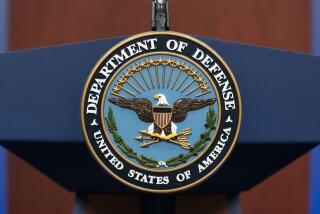Gamble Seen in U.S. Carrier’s Entry Into Narrow Gulf : Navy: Its striking power may outweigh the dangers of shallow waters, limited space and possible attacks.
- Share via
WASHINGTON — The Navy’s unprecedented deployment of a U.S. aircraft carrier into the Persian Gulf today represents a gamble that the supercarrier’s vast striking power will outweigh its vulnerabilities to a range of threats in and around the shallow waters in which it will operate.
As they take up position in the southeastern corner of the gulf, the carrier Independence and its escorts are more vulnerable to Iraqi planes and Iranian speedboats than they are in the wide-open Gulf of Oman and Arabian Sea--previously the closest to the gulf such supercarriers have ventured. Also, they risk tangling with drilling platforms and grounding on sandy bottoms.
But if conflict erupts, the Independence and its more than 60 combat aircraft could strike at key economic and military targets in Kuwait and Iraq, though only briefly and only with the assistance of the U.S. Air Force.
In the narrow gulf, Iraqi planes with Exocet anti-shipping missiles can dash out from their land bases and threaten a carrier with far less warning than they would on the open sea. If Iran and radical Shiite Muslims were to join the battle, they too could launch attacks, particularly from speedboats.
But naval analysts said the greatest threat to the carrier’s ability to operate effectively comes from the Persian Gulf itself. The area is roughly 160 miles wide and at most points is clogged with oil wells, small-boat traffic and islets.
To launch planes effectively and thus contribute significant firepower to a battle, an aircraft carrier must be able to steam in wide and predictable patterns to keep favorable winds moving across its flight deck. Unless the carrier can do so--and it cannot in the obstructed waters of the gulf, say naval officers with experience there--planes cannot take off and land on its deck in the tight schedules such operations require.
The potential for surprise threats and the constraints on a flattop’s ability to maneuver could be a fatal combination in the gulf crisis. Denied its usual warning time of an approaching threat, the Independence might be called upon to maneuver quickly out of danger. Such a quick move risks a brush with the gulf’s shallow bottom--or, worse, an oil rig or another ship. In such an event, aircraft may be stranded in the air without a favorable wind to get them back on the carrier deck, perhaps forced to seek an air base within range.
Why would the Navy brave such risks?
Analysts and defense officials said the Navy’s institutional interests as well as the Pentagon’s desire to project an imposing threat to Iraqi forces from yet another direction account for the first-ever move.
“It’s kind of like Saddam Hussein saying: ‘I’ll blow up all the oil wells if you attack me.’ We’re signaling, posturing, sending strong warnings of what would happen if we go in,” said retired Rear Adm. Eugene Carroll, deputy director of the Washington-based Center for Defense Information.
“The beauty of it is the flexibility” that a carrier would add to the U.S. force, said one naval officer. “You could steam in at night and nobody would know you were there, and suddenly you’re running night operations off the decks” aimed at Iraq. Those operations, he said, would add stress and uncertainty to Iraq’s defensive calculations because they could come from a different direction than Air Force and Marine warplanes.
But the Navy’s desire to shed its peripheral role in the current crisis also helps account for the Navy’s willingness to reverse a longstanding prohibition against operating in the Persian Gulf, analysts said.
“The Navy wants to be part of the first team,” Carroll said. “The Navy’s posturing, flexing its muscles . . signaling to the President and Congress: ‘You can count on us.’ It would be hell to have a war and not be invited.”
That move comes at a time when the Navy is beginning to draft new strategies and missions for the post-Cold War era. As the Army and Air Force have presented elaborate blueprints for their futures in the past year, Navy leaders have resisted the impulse to recast the service, insisting that the Navy’s focus always has been on Third World threats.
But the ships that former Navy Secretary John F. Lehman Jr. called “the backbone of the Navy” previously have been too far from the gulf military buildup for any extended time in the area.
Times staff writer Douglas Jehl, in Saudi Arabia, contributed to this story.
More to Read
Sign up for Essential California
The most important California stories and recommendations in your inbox every morning.
You may occasionally receive promotional content from the Los Angeles Times.














